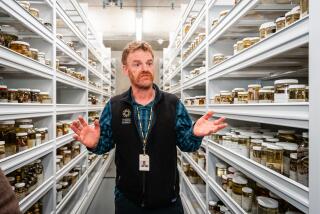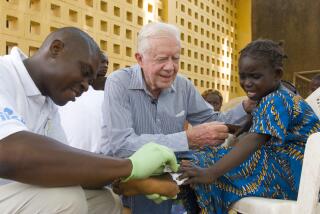Drug Shows Promise as Tropical Blindness Cure
- Share via
BOSTON — In some tropical parts of the world a third of adults are blinded by a hair-thin, 15-inch worm that rolls into a ball and spends the rest of its life releasing its young into a victim’s bloodstream.
The disease is known as river blindness, and as yet there is no cure or adequate method of prevention. The World Health Assn. has put the disease, which is believed to strike 20 million to 50 million people living along the Equator in Africa and Latin America, high on its list of priorities.
“This is a devastating disease which in some areas as much as a third of the adult population is blinded by the parasite,” said Dr. Bruce Greene of Case Western Reserve University Medical School in Cleveland, Ohio.
“It attacks the breadwinners and so devastates the entire family. It’s not just individuals who are the victims, it’s whole families; the social structure of villages are disrupted and destroyed.”
Now, Greene and fellow researchers at Case Western have found a drug, called ivermectin, that preliminary tests show simply and safely combats the disease.
“I think this is the most promising agent to come along in a long time,” said Greene. “It is effective when given in a single oral dose and is relatively free of side effects as far as we can tell.
“The problem in the past with the treatment of river blindness has been that the available drugs caused a very severe reaction. In some ways, the treatment was as bad as the disease itself.”
The drug has researchers particularly optimistic because a single dose seems to be effective, which is important in many Third World countries without the resources to give complex treatments. They are not sure, however, how often the treatment must be given.
Ivermectin has been widely used by veterinarians to kill a variety of parasites but until now had not been used against river blindness.
Researchers have discovered river blindness is transmitted by a black fly, which when biting a human infected with the disease picks up the undeveloped worms, called nematodes, which are about one-hundredth of an inch long. Within eight days, the nematodes inside the fly transform into larvae, which are injected back into a human the next time the fly bites.
The larvae then grow into the fully developed worm, which over its lifetime releases millions of nematodes into a victim’s body. A victim must be bit many times before enough larvae have been injected to cause serious problems.
The nematodes are what cause the majority of the symptoms, such as severe itching and a disfiguring skin condition that can be psychologically disabling. They can also get into a victim’s lymph nodes, causing the gross swelling of limbs and male genitals, called elephantiasis, as well as other complications.






